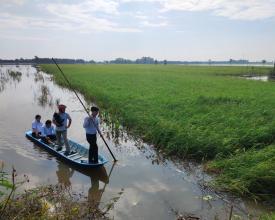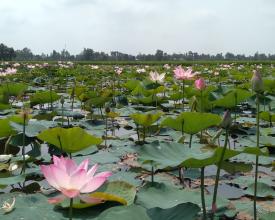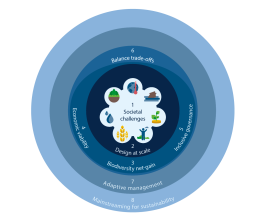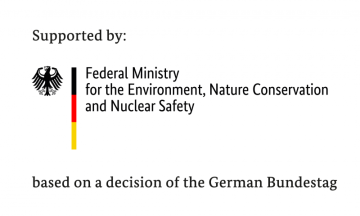
L'agriculture basée sur les inondations dans le delta supérieur du Mékong
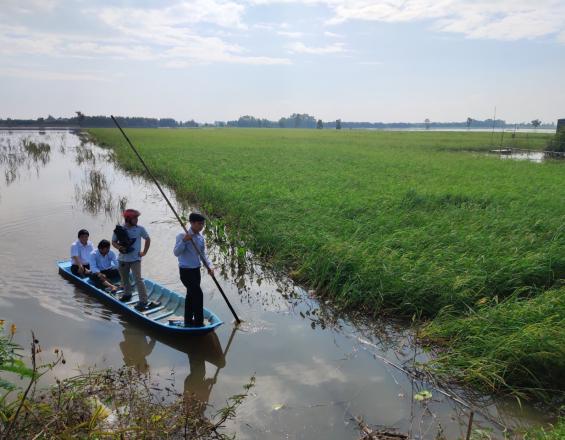
L'UICN a promu et amélioré des modèles d'agriculture et de moyens de subsistance basés sur les inondations (zones humides) dans les provinces vietnamiennes d'An Giang, de Dong Thap et de Long An. Ces pratiques sont basées sur les connaissances et l'expérience des agriculteurs. Les moyens de subsistance basés sur les inondations ont été encouragés en tant qu'alternative financièrement viable et à faible risque à la triple culture du riz (la pratique agricole dominante). Ils contribuent à renforcer la résilience économique et climatique ainsi qu'à conserver et restaurer la biodiversité des zones humides d'eau douce et des plaines d'inondation du delta du Mékong. L'intervention a utilisé une solution basée sur la nature et a pris en compte trois systèmes : les systèmes de riz flottant, les systèmes de culture de lotus et les systèmes d'aquaculture de riz. En outre, en raison de l'augmentation des conditions météorologiques extrêmes, des solutions hybrides ont également été explorées (combinaison de digues et de plaines d'inondation). Les modèles hybrides peuvent mieux permettre des inondations contrôlées et des approches adaptatives pour surmonter les risques de sécheresse et gérer l'arrivée et la décrue des inondations afin de mieux répondre aux besoins des cultures.
Contexte
Défis à relever
La triple monoculture de riz par poldering a été la pratique agricole dominante dans les plaines inondables du delta du Mékong. Cette pratique a entraîné des pertes significatives de la plaine d'inondation saisonnière dans le delta ainsi qu'un déclin des fonctions de l'écosystème, notamment une réduction de la fertilité des terres, une diminution de la résistance aux inondations et une réduction de l'habitat aquatique et de la biodiversité. Les impacts négatifs causés par l'augmentation des risques d'inondation ont également entraîné des problèmes transfrontaliers entre le Viêt Nam et le Cambodge. Pour relever ces défis, le concept d'agriculture fondée sur les inondations en tant que solution fondée sur la nature est apparu dans le cadre d'un programme de travail plus vaste, à partir du plan du delta du Mékong de 2013, qui s'est appuyé sur un certain nombre de projets visant à étudier sa faisabilité. Les études initiales sur les initiatives des agriculteurs et la validation du concept dans les sites pilotes de l'UICN ont été achevées entre 2015 et 2018. Elles ont alimenté la conception et la mise en œuvre de projets similaires dans la région (par exemple, ceux de la Banque mondiale, de l'UICN et de la FAO).
Emplacement
Traiter
Résumé du processus
Les éléments constitutifs mettent en évidence un certain nombre d'idées clés qui ont émergé de l'évaluation de l'intervention agricole basée sur les inondations au Vietnam par rapport aux critères et aux indicateurs de la Norme mondiale de l'UICN pour les solutions basées sur la natureᵀᴹ. Bien qu'ils ne donnent pas une image complète de ce qui peut être considéré comme une solution fondée sur la nature, car tous les critères de la norme sont d'égale importance, ils illustrent certains des facteurs qui ont permis l'introduction réussie de ce nouveau modèle agricole et mettent en évidence les prochaines étapes importantes pour accroître l'adoption et la mise à l'échelle, et assurer la durabilité financière.
Blocs de construction
Construire l'intervention autour de cadres juridiques et politiques favorables
L'intervention "Nature-based Solution" s'est appuyée sur le plan Delta du Mékong de 2013, qui recommandait une double culture de riz à haute valeur ajoutée en combinaison avec une agriculture/aquaculture basée sur les inondations saisonnières pour gérer les risques d'inondation. Cela a influencé la promulgation de la résolution nationale 120, intitulée "Pour un delta du Mékong durable et résilient au climat". La résolution a été adoptée en novembre 2017 et stipule qu'il convient de sélectionner des modèles d'adaptation fondés sur la nature qui sont respectueux de l'environnement et permettent d'atteindre un développement durable basé sur une "vie active avec les inondations". En outre, les forums annuels du delta du Mékong réunissent les gouvernements et les partenaires du développement. Ils offrent un espace d'échange de connaissances sur les enseignements tirés et l'approbation d'une vision commune pour le delta supérieur du Mékong, y compris une évolution vers des utilisations plus naturelles des terres et de l'eau.
Facteurs favorables
Le plan 2013 pour le delta du Mékong tient compte de l'ensemble des défis et des avantages pour la société et soutient la mise en œuvre de systèmes d'agriculture basés sur les inondations. Les défis sociétaux comprennent la perte de la plaine inondable du delta du Mékong et donc de la capacité d'absorption des crues en raison de la riziculture intensive par poldérisation, la réduction de la fertilité des terres et de la zone de recharge des aquifères, le déclin des habitats aquatiques et de la biodiversité ainsi que l'accroissement des inégalités socio-économiques en raison de l'augmentation des coûts des intrants pour compenser le risque accru de parasites, la perte des pêcheries, des sédiments et de la fertilité des sols.
Leçon apprise
Des cadres juridiques et politiques favorables ont ouvert des possibilités de changement dans l'utilisation des terres et facilité les partenariats entre les initiatives connexes pour l'adoption d'une agriculture basée sur les inondations dans les zones inondables et les zones de contrôle des inondations.
Renforcer la collaboration entre les différents projets pour accroître l'impact à grande échelle
La conception de l'intervention a pris en compte les défis qui se posent dans le delta du Mékong et qui ont également été pris en compte dans le plan du delta du Mékong de 2013. L'intervention "Nature-based Solution" a abordé de manière stratégique les lacunes en matière de connaissances, les besoins en capacités des agriculteurs et les défis en matière de planification régionale, en travaillant en collaboration avec d'autres initiatives similaires. L'intervention a répondu aux interactions entre l'environnement et la société en termes d'amélioration des moyens de subsistance par le biais de l'agriculture basée sur les inondations. Alors que les premières interventions pilotes de l'UICN sont restées limitées et à petite échelle, la collaboration entre des projets similaires et les récents développements politiques soutiennent actuellement le développement d'une intervention à grande échelle sur les 1,4 million d'hectares de la plaine inondable du delta du Haut-Mékong.
Facteurs favorables
Les leçons tirées des projets pilotes de l'UICN et les expériences d'autres initiatives similaires sont régulièrement partagées au sein du groupe de travail des partenaires du développement du delta du Mékong et des forums annuels du delta du Mékong. En outre, l'intérêt naissant du monde universitaire pour l'agriculture basée sur les inondations produit déjà des données et des informations pertinentes et renforce la collaboration et les partenariats.
Leçon apprise
Un système hybride d'agriculture basée sur les inondations avec un système de contrôle des inondations par des digues basses pourrait aider à gérer les risques d'inondations précoces/fortes et de sécheresse. Le potentiel le plus élevé se trouve dans les zones inondables fermées avec des digues hautes grâce à l'ouverture de vannes pendant les inondations saisonnières pour restaurer la zone de rétention des crues. Cependant, les projets existants n'ont pas encore abordé ce potentiel. Cela démontre que pour que les interventions de la Solution basée sur la nature aient un impact positif à grande échelle, les interventions à petite échelle (souvent axées sur des projets pilotes), basées sur des projets et limitées dans le temps ne sont pas suffisantes pour relever des défis sociétaux complexes. Néanmoins, les partenariats entre les interventions connexes dans la région ont contribué au développement institutionnel et politique et ont favorisé une meilleure coordination intersectorielle. En outre, une proposition de Fonds vert pour le climat dirigée par l'UICN est en cours de préparation afin d'accroître la participation, d'assurer la continuité des efforts et de relever les défis transfrontaliers.
Soutien financier à la transition vers une agriculture fondée sur les inondations
Plusieurs analyses coûts-avantages ont permis de mieux comprendre les principaux compromis entre les différents systèmes agricoles. Afin d'indemniser les agriculteurs pour la conservation et la restauration des services écosystémiques des plaines d'inondation, ils ont reçu une aide pour couvrir les coûts de la transition vers une agriculture basée sur les inondations et pour résister aux pressions visant à convertir de nouvelles zones à digues basses en zones de contrôle fermées avec des digues hautes qui excluraient les terres des inondations. Dans certaines régions, un modèle hybride a été utilisé, avec des digues basses contrôlant le moment de l'arrivée et de la décrue des inondations pour soutenir la double culture et la culture basée sur les inondations (au lieu de la traditionnelle troisième culture de riz). Dans le cas des systèmes de culture de lotus, l'agriculture basée sur les inondations a permis de diversifier les activités, y compris l'élevage de poissons, l'écotourisme et les possibilités de loisirs.
Facteurs favorables
Une étude de faisabilité a révélé que plusieurs centaines de milliers d'agriculteurs et un certain nombre de villes en aval bénéficieraient financièrement des inondations si l'agriculture saisonnière basée sur les inondations était appliquée. En outre, des analyses coûts-avantages ont été réalisées sur la rentabilité des cultures inondées et du système de culture dans son ensemble par rapport à la monoculture de riz.
Leçon apprise
À l'avenir, les chaînes de valeur, en particulier pour la production de riz, devront être examinées plus en détail pour soutenir le nouveau modèle d'agriculture basé sur les inondations et obtenir le soutien des exportateurs de riz. La prise en compte de la chaîne de valeur garantirait la faisabilité économique du modèle de subsistance basé sur les inondations et inciterait à son adoption. Les consultations et l'analyse des leçons apprises ont permis d'identifier l'accès au marché et le manque de développement de la chaîne de valeur comme les plus grands défis pour l'expansion de l'agriculture basée sur les inondations. Ces éléments sont déjà pris en compte dans la conception d'un futur projet du Fonds vert pour le climat.
Impacts
Les principaux effets positifs de l'agriculture fondée sur les inondations dans le delta supérieur du Mékong sont notamment l'amélioration de la gestion des risques d'inondation grâce au renforcement des fonctions écosystémiques des plaines d'inondation. La conservation ou la restauration des capacités de rétention des crues a favorisé la recharge des aquifères, la réduction de l'affaissement des sols et la conservation ou la restauration de l'habitat aquatique et de la biodiversité. Parmi les autres effets positifs, citons la possibilité de pêcher à l'état sauvage, l'atténuation de l'érosion fluviale grâce au rétablissement de l'hydrologie naturelle des inondations saisonnières et l'augmentation de la fertilité des terres, notamment grâce au dépôt de sédiments dû aux inondations saisonnières.
Bénéficiaires
principalement des agriculteurs locaux, des représentants du gouvernement
Objectifs de développement durable
Histoire

En 2016, la stratégie de rétention des crues pour le delta du Mékong a été proposée, ce qui permet aux provinces de planifier de manière plus coordonnée dans les plaines inondables et de protéger les écosystèmes. Les modèles de subsistance basés sur les inondations, tels que la culture du lotus, les systèmes de riz flottant et la riziculture-aquaculture, sont inclus dans la stratégie en tant qu'options financièrement viables pour les agriculteurs.
La conversion à des pratiques agricoles basées sur les inondations présente de nombreux avantages pour les agriculteurs locaux. La culture intensive du lotus a déjà démontré que le stockage accru des eaux de crue (environ 1 500 m³ pour 1 000 m²) a augmenté l'abondance des poissons, des crabes et des oiseaux aquatiques. En outre, il n'est plus nécessaire d'utiliser des produits chimiques ou des pesticides.
Les avantages de cette solution fondée sur la nature ont également été reconnus par les agriculteurs locaux :
M. Nguyen Ngoc Hon, un cultivateur de lotus expérimenté de la commune de MyHoa, dans le district de Thap Muoi, a déclaré : "Je suis fermement convaincu que les agriculteurs des zones à digues élevées seront prêts à se convertir à la culture du lotus si les bénéfices tirés de cette culture sont supérieurs à ceux de la culture du riz, de sorte que la stratégie de rétention des inondations est un objectif réalisable. Bien entendu, la culture du lotus peut retenir plus d'eau que la culture du riz. Elle permet donc de mieux réguler l'environnement. Je pense que les modèles de lotus peuvent s'adapter aux effets du changement climatique, car ils peuvent aussi bien faire face aux inondations qu'aux sécheresses. La plantation de lotus produit des revenus plus élevés tout en étant meilleure pour l'environnement !
